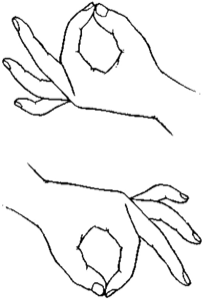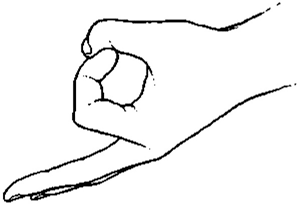
Jnana mudra and Chin mudra
Gesture of consciousness and gesture of know ledge
Place the tip of the thumb on your index fingertip and extend your other fingers. Lay your hand on your thigh in a relaxed way. Do this with each hand.
When your fingers point up to Heaven, it is called the Jnana Mudra; when your fingers point down to Earth, it is called the Chin Mudra.
The mudra is done in two different ways. The first way, as described above, allows the tips of your thumb and index finger to touch each other; for the second variation, the tip of your index finger touches the first thumb joint, and the thumb places light pressure on the nail of your index finger. The first variation is the passive receiving position; the second one is an actively giving position.
These are the two best-known hand positions of Hatha Yoga, and they have an effect on the physical, mental, emotional, and spiritual level.

We find this mudra in many of the Hindu portrayals of deities; in them, the right hand is raised to the heart, and the thumb and index finger, which touch each other, are facing the believer. It is the gesture of proclaiming a teaching. The Buddhists are also familiar with the gesture and call it the Vitarka Mudra (discussion gesture). With this gesture, the deity or Buddha underline the meaning of the words. Christ was also depicted on old Byzantine icons using this gesture; in Catholic liturgy, the priest makes the same gesture after the transubstantiation.
I also find it beautiful when the Jnana Mudra is practiced at the heart. Raise your hand to the level of the heart, letting the index finger and thumb touch. Here they should be directed inward and upward. Here they simply symbolize the wisdom of God. This is the devotion of the human being to divine wisdom and its recognition. There is also a certain tenderness in this gesture that touches my heart.
With these variations of the Jnana Mudra, we already find ourselves on the spiritual level. However, the physical effect should not be overlooked. When this gesture is employed to heal physical complaints, it makes no difference whether the Jnana Mudra or the Chin Mudra is practiced. According to Keshav Dev, this mudra is a universal remedy for improving states of mental tension and disorder, as well as for promoting memory and concentration. It clears the mind-and we all want to have a "clear head" in any situation. It is also used for insomnia, as well as sleepiness depression, and high blood pressure. This mudra can be combined with other mudras and enhances their effects when practiced before or after them. You can hold the gesture with just your right hand, and practice another mudra with your left hand.
This mudra activates the metal element and is associated with the color white. White is the apparent void in which fullness is concealed. White is the color of birth and death, of a new beginning and completion. White is also the color of unity and peace. White clears the mind and brings peace to the soul.
Visualisation
Visualize the color white. First do this by mentally looking at a white object, then do it abstractly. Visualize a white wall and let yourself be surprised by the forms and colors that descend upon you. There may be encoded messages hidden in them.
Affirmation
Divine knowledge makes my life richer and easier; divine wisdom gladdens my heart and shows me the path.

